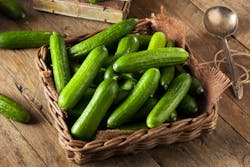Once again, the horticultural industry is studying the possible benefits of raising crops using far-red spectra from LEDs. This time, Canadian grower Red Sun Farms Ontario will trial a lighting system from Sollum Technologies that can dynamically alter the light recipe on mini cucumbers.
A different Sollum customer might also apply it to cannabis growth.
Far red has a longer wavelength than red, and is the longest wavelength that is visible to the human eye, albeit barely.
As LEDs Magazine has been reporting, horticultural interest in applying far-red wavelengths has been picking up. Studies have shown that they can elongate vines (which is sometimes, but not always, beneficial), and can possibly improve sweetness and help to induce desirable plant shapes.
Some growers question the benefits of using far red. Commercial application has so far been limited, but Red Sun might become an early adopter depending on the results of its trial.
The grower is deploying Sollum’s Sun as a Service (SUNaaS) variable lighting system over an area of mini cucumbers at its greenhouse in Kingsville, Ontario, where Red Sun already grows 21.5 acres of tomatoes in natural light, and 6 acres of mini cucumbers supplemented with existing, nondynamic LED lighting.
The size of the mini cucumber trial area is unclear. Red Sun’s idea is to vary the spectra, including doses of far red, using the SUNaaS system. Red Sun will compare mini cucumbers grown under the dynamic conditions with those grown under more static, conventional LEDs.
“This initiative aims to scientifically measure improvements in crop yield, quality and growth efficiency, thereby setting new standards in precision agriculture,” Montreal-based Sollum said in a press release, noting that far-red light has been known to generally improve flowering and growth patterns in crop cultivation.
“Recent studies have demonstrated the significant role of far-red light in certain growth stages, particularly in enhancing desirable traits like stem elongation,” Sollum said. “This aspect is crucial for vining crops such as cucumbers, where longer stem internodes can markedly improve airflow and overall plant health.”
The project could lead to permanent use at new Red Sun greenhouse space.
“We are on the cusp of expanding our facility and looking for the best LED lighting solution available to grow efficiently and sustainably,” said Red Sun general manager Sarah Lombardi. “Our research and development projects are an essential part of our success as a greenhouse producer. Current science is saying that changing the red to far-red ratio in supplemental lighting has a significant impact on plant morphology and we want to see those impacts for ourselves in our own greenhouse.”
Lombardi praised the dynamic aspect of the Sollum system.
"While other lighting solutions allow us to look at the effects of including far-red in fixed spectrum LEDs, Sollum's solution gives us the additional capabilities of observing how dynamically changing that ratio over time might provide added benefits to our crops,” she noted.
She also pointed out that if Red Sun were to deploy the system on a larger scale, then the controllability could help reduce electricity costs because it could automatically dial down light intensity when it makes sense.
That could help offset one challenge in that, according to a Signify study, far-red light can increase electricity consumption compared to other wavelengths.
Red Sun master grower Frank Peters added that “the prospect of developing data-driven lighting recipes tailored to different stages of plant growth is fascinating.”
Meanwhile, Sollum suggested that its first cannabis customer, Varennes, Québec–based Cheers Cannabis, might deploy far-red light.
In recently announcing Cheers as a customer, Sollum noted, “A growing body of research supports that dynamic lighting can significantly improve cannabis production, in particular the ability to adapt the light spectrum to different phases of growth, which can help growers favour specific cannabinoid production. For example, research out of Wageningen University recently indicated that applying higher levels of far-red during the initial rooting stage improves rooting without causing excessive stem elongation. Other studies coming out of Italy, Israel and Canada all indicate that adjusting the light spectrum can allow growers to improve the flower's cannabinoid profile. This level of spectral control is of critical importance to consumers who increasingly demand consistency and accuracy in THC and CBD content.”
Far red is also part of a Sollum study with Delphy Improvement Center in the Netherlands, which is examining the optimal combinations of light and irrigation.
MARK HALPER is a contributing editor for LEDs Magazine, and an energy, technology, and business journalist ([email protected]).
Follow our LinkedIn page for our latest news updates, contributed articles, and commentary, and our Facebook page for events announcements and more. You can also find us on the X platform.

Mark Halper | Contributing Editor, LEDs Magazine, and Business/Energy/Technology Journalist
Mark Halper is a freelance business, technology, and science journalist who covers everything from media moguls to subatomic particles. Halper has written from locations around the world for TIME Magazine, Fortune, Forbes, the New York Times, the Financial Times, the Guardian, CBS, Wired, and many others. A US citizen living in Britain, he cut his journalism teeth cutting and pasting copy for an English-language daily newspaper in Mexico City. Halper has a BA in history from Cornell University.





